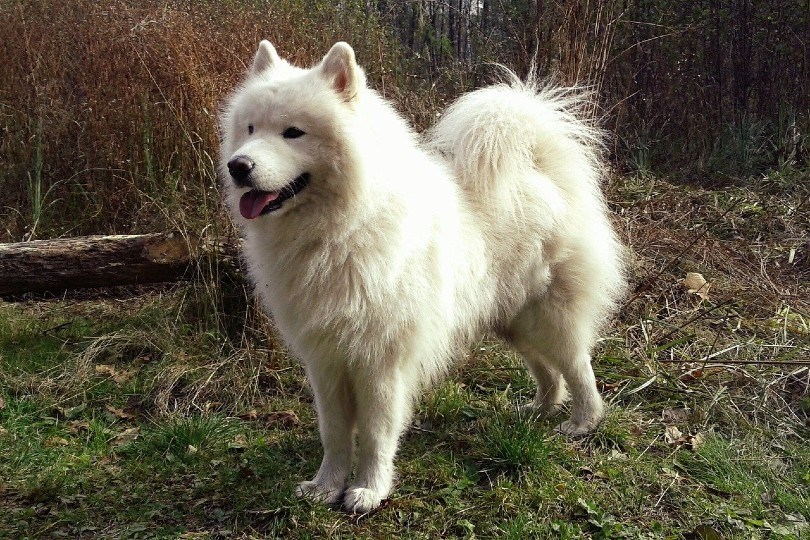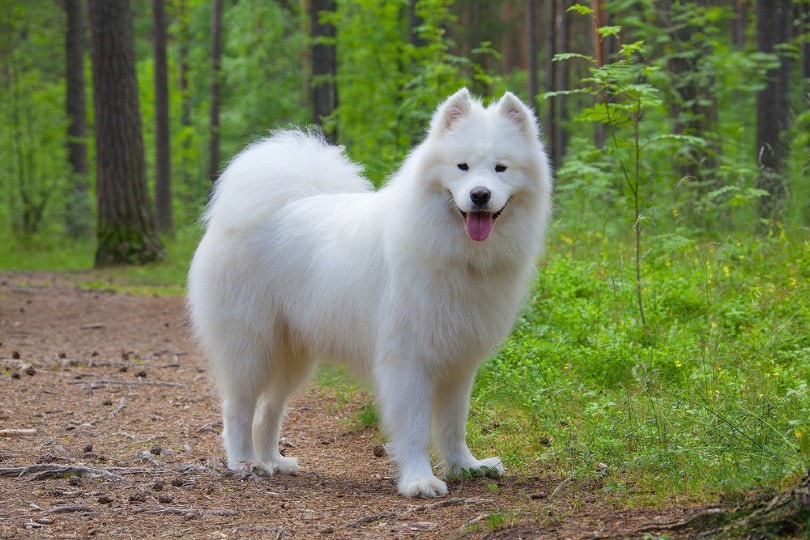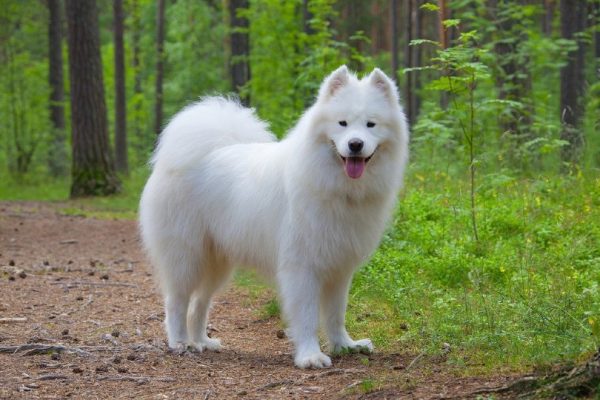Samoyeds, known as “Smiling Sled Dogs” or “Sammies,” were bred to be hardworking dogs in the world’s coldest places. This has resulted in the dog having a thick, white coat that is designed to protect them even when the temperature drops to -60°F.
The Samoyed has a long history and was originally used by the Samoyedic peoples in northwestern Siberia to herd and hunt reindeer. The dogs were loyal and loving toward their people, and the breed still retains these traits today. Eventually, Samoyeds became draft animals, towing boats when reindeer could not be used for this task.
These faithful dogs were beloved by the Samoyedic peoples and served them well. Let’s find out more about these beautiful dogs.
Samoyed Origin
The Samoyed is one of the purest and oldest domestic dog breeds and is closely related to the wolf. A 33,000-year-old fossil was discovered by scientists in 2011.1 Testing proved that the fossil was a mix of dog and wolf, with the dog relation being stronger. The modern Samoyed is the closest modern breed related to that ancient fossil.
The Samoyedic peoples owned and bred Samoyed dogs for thousands of years. These dogs were valued because they offered protection, warmth, and versatility as working dogs. The Samoyedic peoples also considered them to be loving companions. The people relied on these dogs for survival. Samoyed dogs lived with their people, played with children, and kept them all warm and safe.

Samoyeds of the 1800s
The Samoyed breed was solely in Russia until the end of the 1800s. In 1889, the dog was introduced to Europe. From there, the breed spread throughout the world.
Alexandra of Denmark and her husband, King Albert Edward, were known dog lovers and owned several breeds. Alexandra had a kennel built in Norfolk near the end of the 1800s where each of her dogs received the finest accommodations. Each dog had their own bed and fresh water.
After Alexandra received a Samoyed as a gift, she became enamored with the breed. She became a passionate Samoyed breeder, working to promote the dog around the world. Her dedication led to the animal’s popularity. Today, many modern Samoyeds can trace their lineage back to Queen Alexandra’s kennels.
Samoyeds had a reputation as solid draft animals because of their strength and endurance. They were better than horses or mules because they could withstand the temperatures of the Antarctic and ate less food than other common draft animals. In 1895, the Norwegian explorer Fridtjof Nansen used Samoyeds for his journey to the North Pole. The trip was unsuccessful, though, because Nansen did not pack enough food for the journey.
Samoyeds of the 1900s
In 1911, Norwegian explorer Roald Amundsen used Samoyeds for an Antarctic expedition. A team of 52 dogs set out for the South Pole. The pack was led by a dog named Etah, who was the first dog to ever set a paw on the South Pole. Over the course of 99 days, only 12 dogs survived the journey and made it home successfully. Those dogs were then given as gifts to the royal family. Etah, a female dog, went to live out the rest of her days as the pet of Belgian Countess, Princess de Montglyon.
Samoyeds were introduced to the United States in 1906 and recognized by the American Kennel Club that same year. The Samoyed Club of America was created in 1923.
After the Second World War, Samoyeds became more popular across America.

Samoyeds Today
Samoyeds are still in high demand today, and you will pay a hefty price if you’d like to own one of these dogs. The typical price of a Samoyed puppy is $1,000–$3,000. For a dog from a champion bloodline, you can expect to pay up to $6,000.
As a family pet, a Samoyed is a dedicated and loyal companion. They are protective and loving, especially with children. Even today, these dogs love to run and herd anything that they can. They also have high prey drives from their days as hunters.
Their thick, white coats shed heavily and require frequent brushing to keep them under control. While they once enjoyed living outside, they should not be required to do so today. Samoyeds are social animals that enjoy being with their people more than anything.
Conclusion
Samoyeds have a rich history as working dogs and loyal companions. They’ve come a long way from their sled dog roots, but many of their desirable traits remain. We have these dogs to thank for the ability to explore the coldest parts of the world. The Samoyedic peoples made the dogs the friendly, loving companions that they are today.
If you’re considering a Samoyed for your household, know that you’re getting a dog with plenty of energy, love, and dog hair to share.
See Also:
- How to Train a Samoyed: 12 Important Tips
- Male vs Female Samoyed: What’s The Difference (With Pictures)
Featured Image Credit: Nik Tsvetkov, Shutterstock










